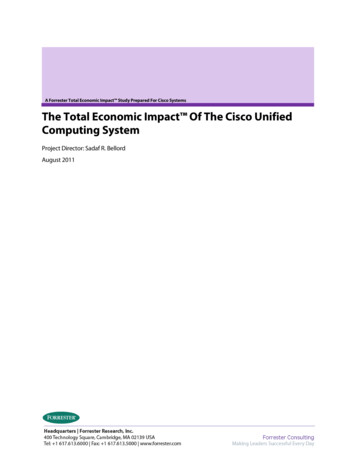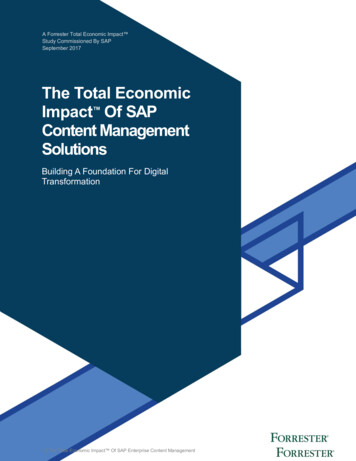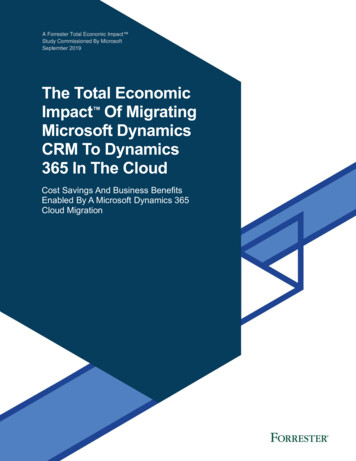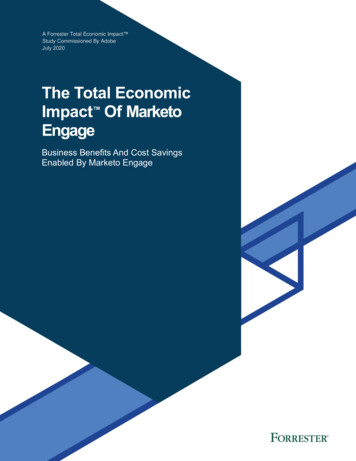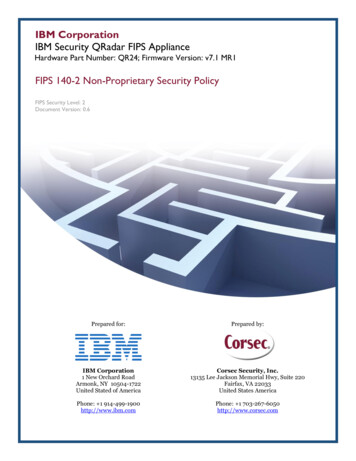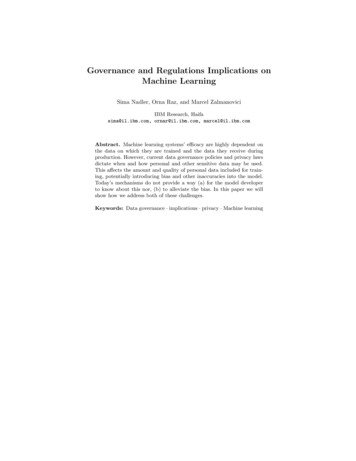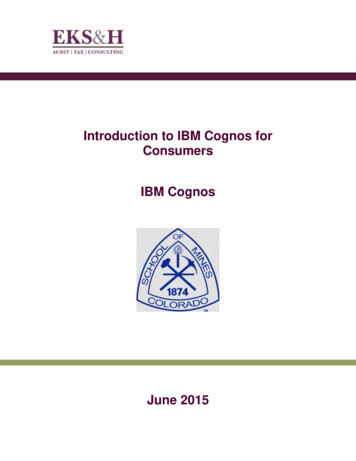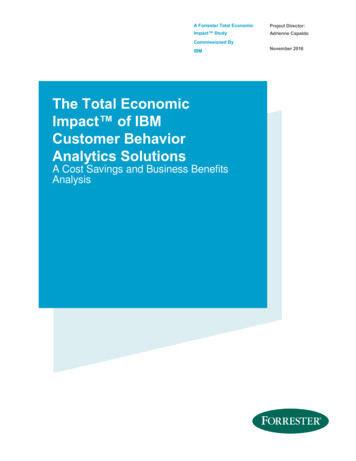
Transcription
A Forrester Total EconomicProject Director:Impact StudyAdrienne CapaldoCommissioned ByIBMThe Total EconomicImpact of IBMCustomer BehaviorAnalytics SolutionsA Cost Savings and Business BenefitsAnalysisNovember 2016
Table Of ContentsExecutive Summary . 3Disclosures . 5TEI Framework and Methodology . 6Analysis . 7Financial Summary . 23IBM Customer Behavior Analytics: Overview . 24Appendix A: Total Economic Impact Overview . 25Appendix B: Glossary . 26Appendix C: Endnotes . 26ABOUT FORRESTER CONSULTINGForrester Consulting provides independent and objective research-basedconsulting to help leaders succeed in their organizations. Ranging in scope froma short strategy session to custom projects, Forrester’s Consulting servicesconnect you directly with research analysts who apply expert insight to yourspecific business challenges. For more information, visitforrester.com/consulting. 2016, Forrester Research, Inc. All rights reserved. Unauthorized reproduction is strictly prohibited.Information is based on best available resources. Opinions reflect judgment at the time and are subject tochange. Forrester , Technographics , Forrester Wave, RoleView, TechRadar, and Total Economic Impactare trademarks of Forrester Research, Inc. All other trademarks are the property of their respectivecompanies. For additional information, go to www.forrester.com.
3Executive SummaryOrganizations are under a great amount of stress to deliver outstanding omnichannel interactions to their customers.Creating a positive customer experience in a mobile app or online is at the core of increasing future revenues, improvingcustomer satisfaction, and maintaining strong customer relationships to retain loyal customers. Perhaps more importantly,customer expectations for web and mobile experience are at an all-time high. With so many options available to customers, itis integral to an organization’s success that it delivers strong customer experiences.To deliver these exceptional customer interactions, organizations must pay close attention to their web and mobile designand usability. To better understand this, organizations need a way to have visibility into their customers’ online and mobileexperiences. Companies must be able to quickly gather and analyze data across channels in a way that allows them to pulland act on valuable, data-backed insights to optimize their channels. This means organizations are in need of a solution thatwill help them understand their customers’ experiences across channels, and ultimately help organizations transform theirdigital channels for superior design and customer experience.IBM commissioned Forrester Consulting to conduct a Total Economic Impact (TEI) study and examine the potential returnon investment (ROI) enterprises may realize by investing in IBM's customer behavior analytics solutions, which include asoftware-as-a-service (SaaS) solution, IBM Watson Customer Experience Analytics, and an on-premise solution, IBMTealeaf CX. The purpose of this study is to provide readers with a framework to evaluate the potential financial impact ofthese customer behavior analytics solutions from IBM, which include struggle analytics, session replay, eventing and alertingcapabilities. Specifically, the analysis is focused on users of the previously-named IBM Tealeaf Customer Experience onCloud solution. Tealeaf’s core behavior analytics capabilities are now built into IBM Watson Customer Experience Analytics.To better understand the benefits, costs, and risks associated with this investment, Forrester interviewed current IBMcustomer behavior analytics customers and also conducted an online survey of 30 customer behavior analytics users withmultiple years’ experience using the solution within their organizations. IBM customer behavior analytics provide quantitativeand qualitative information necessary to understand customers’ experiences on the Web and mobile applications. Thesolution helps organizations gather information to better understand customer behavior across web and mobile platforms.IBM’S CUSTOMER BEHAVIOR ANALYTICS SOLUTIONS HELP IMPROVE CUSTOMER EXPERIENCE ACROSSCHANNELS, INCREASING CONVERSION RATES AND IMPROVING CUSTOMER RETENTIONOur interviews, online surveys, and subsequent financial analysis found that a composite organization based on this analysisexperienced the risk-adjusted ROI, benefits, and costs shown in Figure 1.1 The composite organization analysis points tobenefits of over 13.4 million per year versus deployment costs of approximately 4.5 million, adding up to a net presentvalue (NPV) of over 8.9 million.FIGURE 1Financial Summary Showing Three-Year Risk-Adjusted ResultsROI:196%NPV: 8.9MPayback period:4 months
4Source: Forrester Research, Inc.›Benefits. The composite organization experienced the following risk-adjusted benefits that represent those experienced bythe interviewed companies: Incremental revenue from increases in online and mobile conversion rates of sales and transactions. Byusing IBM's customer behavior analytics solutions to eliminate key issues that led to abandonment of online andmobile transactions, the composite organization increased its conversion rate by 3.6% for online transactions and by2.5% for mobile transactions. This led to an increase in revenue of over 13 million over the three years. Incremental revenue resulting from increases in customer retention. IBM's customer behavior analyticssolutions also helped improve the overall online and mobile experience, resulting in a 1.6% increase for onlinecustomer retention and a 1.75% increase for mobile customer retention. This results in over 1.1 million in additionalrevenue over the three years. Reduction in time spent on reproduction of online and mobile issues. IBM's customer behavior analyticssolutions increased the ease with which online and mobile issues were reproduced, reducing the reproduction timeby 90% by Year 3 for online issues and by 70% for mobile issues. This led to almost 1.3 million in saved time overthe three years. Cost savings from development prioritization. The composite organization used the data produced by IBM'scustomer behavior analytics solutions to better understand the impact of online and mobile issues on its customers,and it was able to better prioritize its development efforts to focus on only the most beneficial issues. This led to asavings of over 350,000 over the three years. Cost savings from SaaS deployment. The composite organization chose Watson Customer Experience Analytics,a SaaS solution, avoiding costs associated with servers, storage, and maintenance, as well as avoiding labor costsfor deploying and maintaining an on-premises environment. Over the three years, this saves the compositeorganization approximately 375,300.›Costs. The composite organization experienced the following risk-adjusted costs: Cloud licensing fees, professional services, and training costs. These are fees paid to IBM for the use ofWatson Customer Experience Analytics. In addition, it covers costs paid to IBM’s professional services team forsupport on planning, implementing, and deploying Watson Customer Experience Analytics. This also includes thecost associated with training administrators who manage the system. The composite organization also leveragesprofessional services to effectively train staff to get the most from Watson Customer Experience Analytics. Implementation and planning costs. These are the internal costs associated with the planning, implementation,and deployment of Watson Customer Experience Analytics. Incremental customer experience staff. The composite organization has several members of the customerexperience staff serving as the champions of Watson Customer Experience Analytics, spending part of their timeworking with the data to help other members of the team make improvements to the online and mobile channels. InYear 1, this works out to the equivalent of one full-time employee (FTE), and in subsequent years, it works out to theequivalent of two FTEs. Incremental IT administration support staff. To support the deployment of Watson Customer ExperienceAnalytics, the composite organization would require about 15% of one FTE’s time. Additional network bandwidth. While the composite organization saves money on servers, storage, andmaintenance associated with an on-premises deployment, to support the Watson Customer Experience Analyticsdeployment the organization incurs costs associated with additional network bandwidth.
5DisclosuresThe reader should be aware of the following:›››The study is commissioned by IBM and delivered by Forrester Consulting. It is not meant to be used as a competitiveanalysis.Forrester makes no assumptions as to the potential ROI that other organizations will receive. Forrester strongly advisesthat readers use their own estimates within the framework provided in the report to determine the appropriateness of aninvestment in Watson Customer Experience Analytics or Tealeaf CX.IBM reviewed and provided feedback to Forrester, but Forrester maintains editorial control over the study and its findingsand does not accept changes to the study that contradict Forrester’s findings or obscure the meaning of the study.
6TEI Framework and MethodologyINTRODUCTIONFrom the information provided in the interviews and online surveys, Forrester has constructed a Total Economic Impact (TEI)framework for those organizations considering implementing Watson Customer Experience Analytics or Tealeaf CX. Theobjective of the framework is to identify the cost, benefit, flexibility, and risk factors that affect the investment decision, to helporganizations understand how to take advantage of specific benefits, reduce costs, and improve the overall business goalsof winning, serving, and retaining customers.APPROACH AND METHODOLOGYForrester took a multistep approach to evaluate the impact that IBM’s solution can have on an organization (see Figure 2).Specifically, we:›››››Interviewed IBM marketing, sales, and/or consulting personnel, along with Forrester analysts, to gather data relative tocustomer behavior analytics and the marketplace for customer behavior analytics.Interviewed existing IBM customer behavior analytics users and surveyed 30 organizations currently using IBM customerbehavior analytics to obtain data with respect to costs, benefits, and risks.Designed a composite organization based on characteristics of the interviewed organizations.Constructed a financial model representative of the survey data using the TEI methodology. The financial model ispopulated with the cost and benefit data obtained from the interviews and surveys as applied to the compositeorganization.Risk-adjusted the financial model based on issues and concerns the surveyed and interviewed organizations highlighted.Risk adjustment is a key part of the TEI methodology. While interviewed organizations provided cost and benefit estimates,some categories included a broad range of responses or had a number of outside forces that might have affected theresults. For that reason, some cost and benefit totals have been risk-adjusted and are detailed in each relevant section.Forrester employed four fundamental elements of TEI in modeling IBM’s customer behavior analytics service: benefits,costs, flexibility, and risks.Given the increasing sophistication enterprises have regarding ROI analyses related to IT investments, Forrester’s TEImethodology serves to provide a complete picture of the total economic impact of purchase decisions. Please see AppendixB for additional information on the TEI methodology.FIGURE 2TEI ApproachPerformdue diligenceSource: Forrester Research, Inc.Conductinterviews andonline almodel usingTEI frameworkWritecase study
7AnalysisCOMPOSITE ORGANIZATIONFor this study, Forrester conducted interviews and an online survey of 30 organizations in the US that have deployed one ofIBM's customer behavior analytics solutions. Online survey participants included line-of-business and IT professionals whomake, influence, or have knowledge around decisions related to customer experience technology. While a wide variety ofindustries were represented, most respondents were from retail organizations. Other industries included financial services,insurance, hospitality, and other services.Based on the interviews and online surveys, Forrester constructed a TEI framework, a composite company, and anassociated ROI analysis that illustrates the areas financially affected. The composite organization that Forrester synthesizedfrom these results represents an organization with the following characteristics:›››››It is a US-based retail organization with an international presence with annual revenues of 1.1 billion, with a strong onlineand mobile presence, as well as brick-and-mortar locations in the US.The organization has about 120,000 daily visitors to its online sites (which equates to 43.8 million annual visitors), and82,500 daily visitors (which equates to 30.1 million visitors per year) to its mobile platforms.Prior to implementing an IBM customer behavior analytics solution, the customer experience group struggled to fullyunderstand the numerous challenges that its state-of-the-art website presents. It was unable to easily reproducereported issues to identify the problem and prioritize its impact on site visitors. With the maturation of its digital andmobile business, the composite company is now focused on optimizing its conversion rate and is committed to improvingthe customer experience to increase revenues.A vice president of customer experience wants to find a solution to: 1) improve the conversion rate of online and mobilecustomers; 2) assist technology staff in clearly identifying problems and their resolutions; 3) retain customers so they buyagain; and 4) optimize the cross-channel experience for customers.After a request for proposal (RFP) process, the composite organization selected IBM's customer behavior analyticssolution. The composite organization implemented Watson Customer Experience Analytics. It worked with theprofessional services team at IBM to implement its program. The organization now has 100 million events per monthcaptured by its Watson Customer Experience Analytics solution.It is important to note that while this composite focuses on a retail organization, Forrester spoke with a variety oforganizations, including financial services, insurance, and hospitality organizations, as well as retail. The purpose of thisdocument is to build out a framework that an organization can use to determine its potential ROI, regardless of industry.INTERVIEW HIGHLIGHTSThe interviews and surveys uncovered the following drivers and impacts behind the need for IBM’s solution:›Organizations need to improve the cross-channel experience of their customers. Each organization we spoke withand surveyed understood that it is operating in an environment with increased customer attention across channels.Whether in an online or mobile platform, organizations are seeing higher levels of interactions across their channels. As weheard from one interviewee regarding their mobile platform: “We’ve seen tremendous adoption of our mobile channels.The amount of time they spend using mobile sites or apps has increased dramatically. We are now interacting with ourcustomers a lot more frequently than we would have through more traditional channels, even some of the digital channels.”With this increase in demand comes an increase in competition. In order to stay competitive, these organizations arelooking for ways to optimize their mobile and web channels in order to improve their overall customer experience. Theseorganizations know that their customers have come to expect top-notch customer experiences and will move on to another
8organization if they are unable to get what they need. Providing exceptional online and mobile experiences is key towinning and retaining customers.››To meet the needs of the customer, organizations are looking for solutions that help them to better understandthe current customer experience and identify where customers struggle. To create an optimized experience, theorganizations we spoke with highlighted the fact that they needed to fully understand how users interact with, and more sostruggle with, their websites and mobile applications. Both our interviewees and survey respondents discussed the need togain visibility into how their customers were using their web and mobile channels, and to see where and how theystruggled in context. One organization said: “We wanted to better understand our client experience — so what strugglesour clients were seeing in the system, what we could learn, what we could measure . . . and then how can we make thoseexperiences the most interactions, more efficient, easier, more intuitive?” As another organization told us, “We use it as away to understand the behavior, to see if there are opportunities for us to improve the way we have implemented certainfeatures.”Companies are looking at the long-term impact of improved customer experience. The companies we spoke withwant to not only discover key quick-fixes but also gain insights into higher-level trends to create continuous customerexperience improvements. Make no mistake, these organizations are seeing immediate impacts from IBM customerbehavior analytics. Many organizations note that their initial adoption of the solution was based on the ability of the productto help them generate big wins by quickly diagnosing conversion and customer experience issues within the first year. Aswe heard from one organization, “Right at the beginning, we did a lot of quick hits and got a ton of success out of it.” Itnoted, “Within three months, we had recovered the costs of [the solution] just with a couple big wins.” However, smartcompanies know they need to have a better, deeper understanding of why their customers are succeeding or failing sothey can take action to address the customer experience issues before they become a larger problem. Companies want asolution that helps them make continuous customer experience improvements to grow and retain their customer loyalty.Our interviews uncovered that IBM customer behavior analytics solutions were selected not only because they helped theorganization with the above, but because they:››››Provide instant visibility into how users interact with mobile and web channels. Our interviewees told us that theywere impressed with the level of visibility the solution created into their different sites and apps.Bring instant credibility to issues. Watson Customer Experience Analytics provides the ability to pinpoint the exactreason a customer struggled or abandoned a transaction. One company noted, “The proliferation of browsers around theworld is something that websites deal with; even if you have quality people monitoring things, you might not be able toreproduce it because you’re using the wrong browser.” Another noted: “There’s so much power in presenting to otherpeople and being able to show them what happened instead of trying to tell them. People will take a bigger stand on yourbehalf if they’ve seen it themselves.” Watson Customer Experience Analytics enables organizations
software-as-a-service (SaaS) solution, IBM Watson Customer Experience Analytics, and an on-premise solution, IBM Tealeaf CX. The purpose of this study is to provide readers with a framework to evaluate the potential financial impact of these customer behavior analytics solutions from IBM, which include struggle analytics, session replay .


